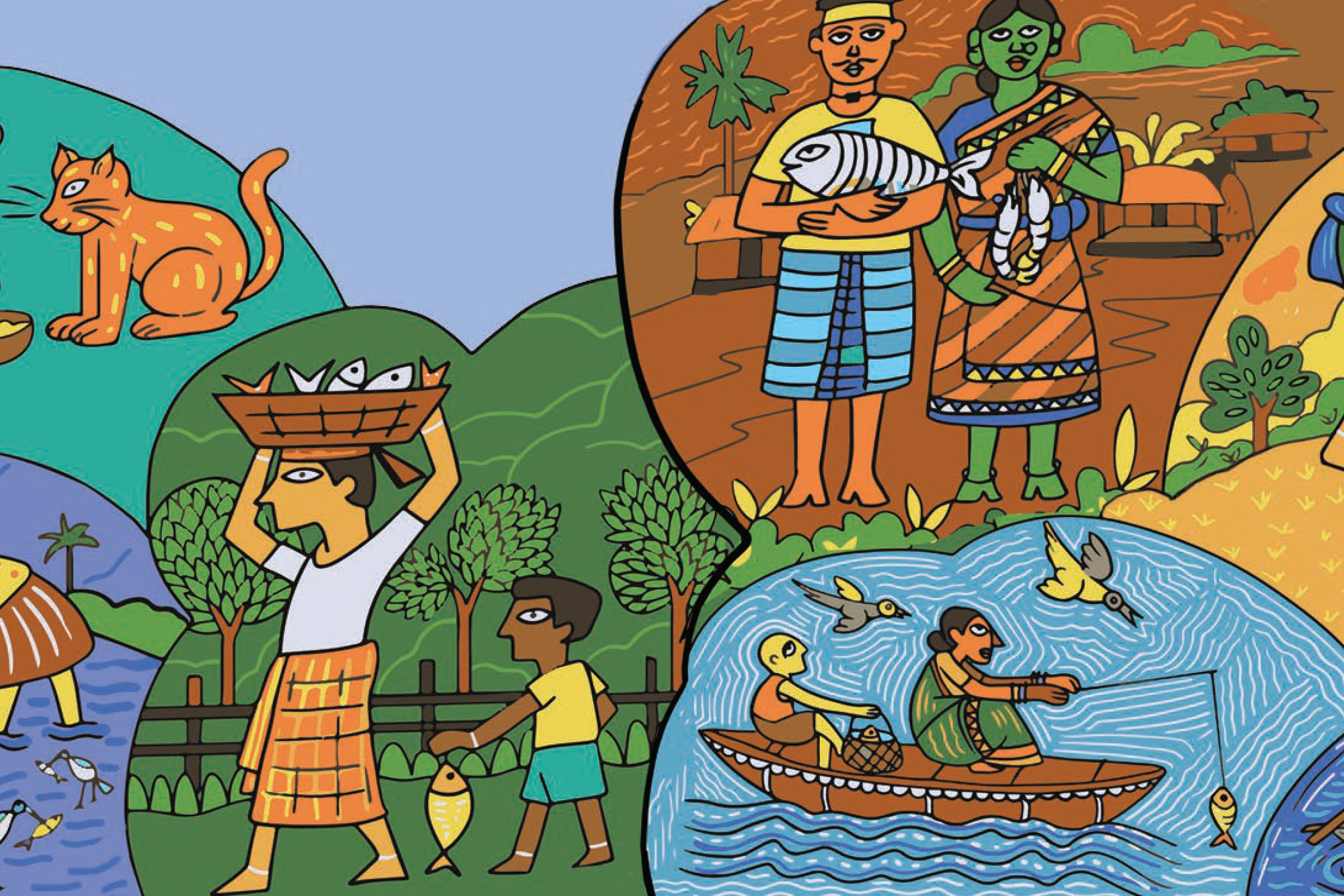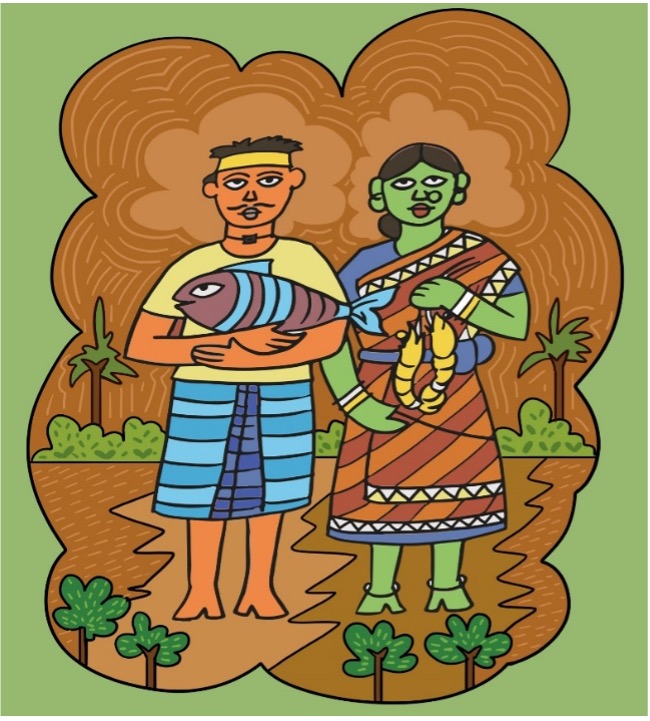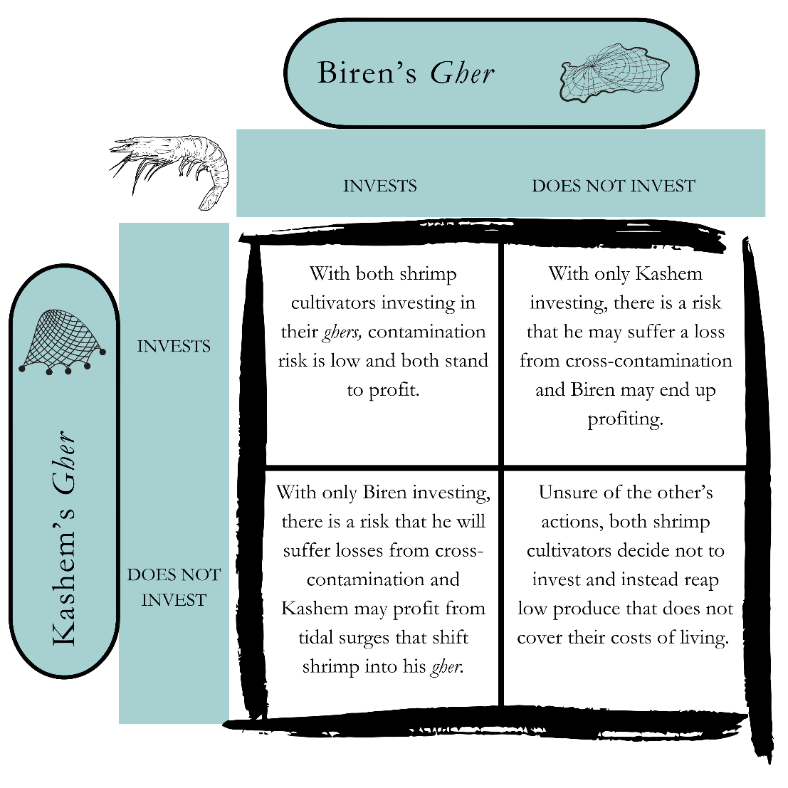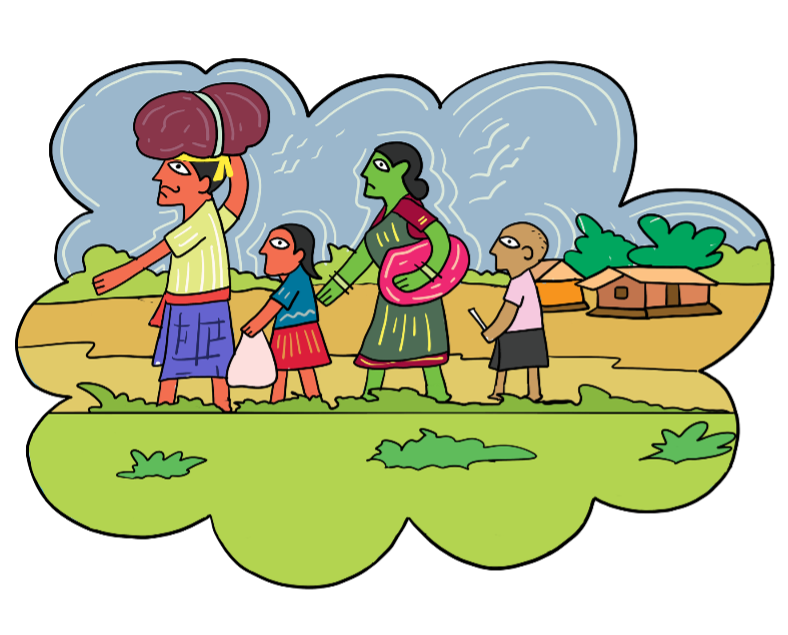
Resource
Strategic Frugality – A Case Study of Cross-Border Migration Among Shrimp Cultivators in Khulna
The findings of this case study are based on focus group discussions carried out by the Bangladesh Program to End Modern Slavery (B-PEMS) AugroJatra team with shrimp cultivators in Charbandha village, in Paikgacha upazila in Khulna. All names used in this case study have been changed to protect anonymity.
Shrimp Cultivation – An Enforced Livelihood Decision

In Khulna and Satkhira districts in southwestern Bangladesh, shrimp cultivation is a primary source of livelihood. In particular, low-lying regions of Satkhira and Khulna have vast areas of land that are perpetually inundated with brackish water, creating the perfect conditions for shrimp cultivation. Despite this, the region did not see a shrimp cultivation boom until the 1980s, when large-scale interventions to control the flow of river water in the region through the construction of embankments, coupled with the lack of upstream water mobility created by the building of India’s Farakka Dam, led to a state of perennial waterlogging.[i] Eventually, the waterlogging attracted big businesses to begin extensive shrimp farming on what was once farmland. In order to sustain shrimp farming, it was in the interests of the big businesses to sustain waterlogging. Today, influential individuals control the flow of water through sluice gates and lease out canals to create favorable conditions for shrimp farming, which has led to clashes between these businessmen and local communities resistant to the intentional saline water inundation.[ii] However, they have largely fought a losing battle and with no ability to farm their inundated fields, local communities reluctantly turned to shrimp cultivation as the only viable source of income.[iii] This was the fate of twenty villagers living in Charbandha village in Paikgacha, Khulna. According to the villagers, once the water came in during the 1980s, they were forced to give up large parts of their lands on lease (colloquially called ‘hari’) to the large shrimp farms that were established. What this meant in practice was that they were effectively permitting continuous waterlogging not only for their own lands but for others who owned land next to them.[i]
“We are shrimp cultivators by force, not by choice. Once the water came in, it inundated all our lands and never ceded. There is nothing else to do but to cultivate shrimp as the water is too saline for other types of fish. By the time the water level goes down in the winter, it is impossible to grow crops because the soil is too saline.”
– Suresh, Shrimp Cultivator
Having leased out their land to big shrimp farms, the villagers engaged in a process of verbal leasing, whereby they divided the rest of the land amongst themselves to practice small-scale shrimp cultivation. In fact, all of the villagers reported that they were currently cultivating shrimp on land that did not initially belong to them but that they had acquired through this process of verbal leasing.[i]
Frugal Practices & Low Yield
While shrimp cultivation is undeniably a booming business in Bangladesh, its profitability does not seem to have filtered through to the farmers themselves. By and large, local cultivators cannot adequately profit from shrimp cultivation, in spite of the huge local and global demand for shrimp. Shrimp cultivation does not require deep water and can be carried out in ghers, which are modified rice fields set up with a thin-mesh barrier on all sides to prevent the shrimp from flowing out. In theory, the practice is not difficult because of the favorable conditions created by the unmoving saline water in those regions. However, in practice, shrimp cultivation is a challenging process for smallholder farmers. Unless an individual has a very large stretch of land that they can modify into a gher, their fate is inextricably tied to the practices of the cultivators next to them. Shrimp hatchlings are sensitive to changes in temperature and cultivation practices and easily susceptible to death from disease and stress. While it is relatively cheap to engage in traditional shrimp farming methods, they aren’t profitable enough to sustain a household. In order to increase yield and thus productivity, cultivators need to expend a substantial amount of capital on their ghers, and hope that their surrounding fields also follow suit. This includes purchasing more expensive shrimp fry that leads to higher yield, increasing the height of embankments, and providing better shrimp feed. Because of the permeable nature of water, it is relatively easy for cross-contamination to take place, especially across small ghers that are next to one another.[ii] With hundreds and sometimes thousands of individual ghers next to one another, it becomes impossible to engage in cooperation and harmonization of cultivation practices. If one cultivator invests in their gher and engages in improved cultivation practices, they stand to risk losing their investment if water-borne cross-contaminants enter into their gher from the surrounding areas. This uncertainty leads to all of the smallholder cultivators adopting a strategy of frugality, whereby none of them invest in their ghers and receive meager returns through poor yield. This uncertainty is further exacerbated by the threat of cyclones, which often cause storm surges in the region. The storm surge displaces water and the shrimp from one gher to another and makes cultivators even more reluctant to invest in the process.
Water flows from one gher to another and there’s no way to stop it. We don’t have enough money to build large dikes across our ghers and if there’s a cyclone, that leads to storm surges that further inundate the fields. In such instances, it becomes a matter of fate who gets the most shrimp.
– Dipen, Shrimp Cultivator

Simplified, the villagers display decision making patterns akin to the famous Prisoner’s Dilemma strategy, whereby both prisoners, or players, choose sub-optimal strategies due to uncertainty of the other’s actions. In this instance, villagers collectively choose to not invest and thereby forego the large amount of profits that they could have recouped. The risk-averse nature of the cultivators leads to low income during growing seasons, which ultimately forces the villagers to seek out alternative income sources during lean seasons.
Due to the frugal strategies employed by the shrimp cultivators, they are not able to effectively tap into the large shrimp markets. The meager returns dry up during the winter, along with the water, leaving behind a thin layer of brackish water suitable for neither shrimp cultivation nor agriculture. During this season, many villagers engage in seasonal migration, most often across the border to various cities of India. When interviewed, they cited a number of reasons for engaging in cross-border migration. Firstly, they cited the segmented nature of waged labor markets in Bangladesh, where workers often get jobs based on their relationship and familiarity with recruiters. Secondly, villagers pointed to both the higher wages in Indian cities and the ease of labor mobility from one site to another. The higher demand for informal workers in West Bengal and other neighboring Indian states meant that a large number of irregular migrants from Bangladesh often engages in this work. A third factor that impacted the community’s cross-border patterns was their religious affiliation. All of the shrimp cultivators in Charbandha village are Hindu and they have familial ties with persons living in India. As a result, the villagers found it more profitable to obtain a tourist visa, cross the border, and engage in informal work as opposed to seeking out opportunities within the borders of Bangladesh.
“Almost every year, some of us migrate to India for a few months. I’ve worked in brick kilns and construction sites in West Bengal and in Hyderbad. It’s easier to find work there. You can just go to a construction site and stand outside, and you will be hired for a day. It’s more difficult inside the country, where contracts for manual labor pass through contractors who recruit from within their favored groups.”
– Hari, Shrimp Cultivator
The migratory patterns of shrimp cultivators are directly tied to both their low-investment strategies for shrimp farming and the challenges of engaging in on-farm activities during the lean season. It is important to note that none of the villagers reported crossing into India without a visa, although some did so with tourist visas. Generally, villagers did not prefer clandestine border crossing methods as they cost more than obtaining a visa and they understand how to apply for visas to the Indian High Commission in Khulna.

Rights Abuses in India
While the shrimp cultivators noted their preference for seasonal work in India, they also cited a number of challenges they had experienced during their stay in India. As irregular migrants, the villagers did not have recourse to compensation in case of work-related injuries and could not file grievances against employers if wages were not paid. In one instance, a villager reported having broken his arm while working at a construction site but he did not receive compensationfor his injuries. Villagers also reported the regularity with which wages were withheld by employers, but high labor mobility, coupled with the high demand, meant that they could regularly switch jobs. Their irregular status also meant that they could not approach law enforcement to seek support if they were victims of crimes such as theft or physical abuse.
Climate Change and Human Intervention
By and large, the biggest impacts on the livelihoods of shrimp cultivators in Charbandha village have been due to direct human intervention. The construction of the Farakka Dam, the failure of the embankments, and the political economy of shrimp cultivation have led to the marginalization of this community and their deprivation from agricultural lands. These human interventions have over time transformed the nature of the soil in the region, with saline intrusion making it unsuitable for crops. However, in recent years, indirect impacts from a changing climate have also affected their shrimp cultivation prospects. Higher temperatures during the shrimp production period have been attributed to low yield as it leads to the onset of disease and heat related stress among the shrimp population.[i] The lack of investment and water management practices exacerbate the risks associated with high temperatures. These factors have continued to whittle away the already low returns that villagers in Charbandha union receive from shrimp cultivation.
Author: Ahmad Ibrahim (Program, Research, and Knowledge Management Advisor)
Facilitation: Ahmad Ibrahim, Zakia Naznin (Senior Technical Lead, Climate Change) & Abdul Gaffar (Senior Manager – Monitoring, Evaluation, Results, and Learning)
This case study was funded by a grant from the United States Department of State. The opinions, findings and conclusions stated herein are those of the author and do not necessarily reflect those of the United States Department of State.
[i] Rahman, Sadiqur and Islam, Ariful; ‘3 decades on, a man-made waterlogging crisis lingers in Bhabadaha’, The Business Standard, Last Modified – 22 March 2023, Link – https://www.tbsnews.net/features/panorama/3-decades-man-made-waterlogging-crisis-lingers-bhabodah-603646
[ii] The Daily Star, ‘Farmers resist saline water based shrimp farming’, Last Modified – 11 May 2009, Link – https://www.thedailystar.net/news-detail-87724
[iii] Md. Rashedur Rahman, Kazuo Ando & Shinya Takeda (2014) Development of shrimp-based cropping systems in the coastal area of Bangladesh: a village-level study in Satkhira district, Journal of Land Use Science, 9:2, 195-210, DOI: 10.1080/1747423X.2013.786147
[iv] Afroz, S., Cramb, R. and Grünbühel, C. (2017), Exclusion and Counter-exclusion: The Struggle over Shrimp Farming in a Coastal Village in Bangladesh. Development and Change, 48: 692-720. https://doi.org/10.1111/dech.12310
[v] The verbal leasing process is a common practice in shrimp cultivation, which requires a moderate to large amount of land. Through this practice, a cultivator can increase his shrimp gher by renting land next to his plot to create sufficient space for cultivation. In return, he agrees to provide a portion of his landholding elsewhere to another cultivator for the same purpose. In this way, a complex web of inter-leasing takes place through which shrimp ghers are prepared.
[vi] Md. Arif Chowdhury, Yahya Khairun, Farmers’ Local Knowledge in Extensive Shrimp Farming Systems in Coastal Bangladesh, APCBEE Procedia, Volume 8, 2014, Pages 125-130, ISSN 2212-6708, https://doi.org/10.1016/j.apcbee.2014.03.013
[vii] Islam, Md & Shariful, Islam & Wahab, Md. (2016). Impacts of climate change on shrimp farming in the South-West coastal region of Bangladesh. Research in Agriculture Livestock and Fisheries. 3. 227. 10.3329/ralf.v3i1.27881.
